Maryland is a mid-Atlantic state surrounded by abundant coastlines and waterways. Almost 40% of its land surface is covered in forests, providing the perfect environment for many bird species. Discover 12 blue birds in Maryland and learn about their habitats, appearance, foraging behavior, and other fun facts.

1. Black-Throated Blue Warbler

The black-throated blue warbler breeds and migrates through Maryland inhabiting shrubby and forested areas.
©iStock.com/BrianLasenby
Range and Habitat: The black-throated blue warbler breeds in the far western portion of Maryland and migrates through the rest of the state. You can find them in shrubby or forested areas from May to June and September to October.
Coloring: Colors include midnight blue, black, and white.
Food and Foraging Behavior: They primarily eat insects and forage methodically by gleaning prey from the undersides of leaves.
Fun Fact: Males and females look so different researchers once thought they were separate species.
2. Blue-Gray Gnatcatcher

The blue-gray gnatcatcher has a long, thin, pointed beak, which allows it to pluck an insect out of the air.
©iStock.com/Matthew Jolley
Range and Habitat: The blue-gray gnatcatcher breeds in Maryland and throughout most of the southeast. Their breeding habitat consists of deciduous forests with oak, ash, maple, or southern pine.
Coloring: They’re bluish-gray, light gray, white, and black.
Food and Foraging Behavior: They are active foragers, busily searching through trees and shrubs for insects and spiders.
Fun Fact: Males are highly territorial and will chase and confront intruders.
3. Blue Jay
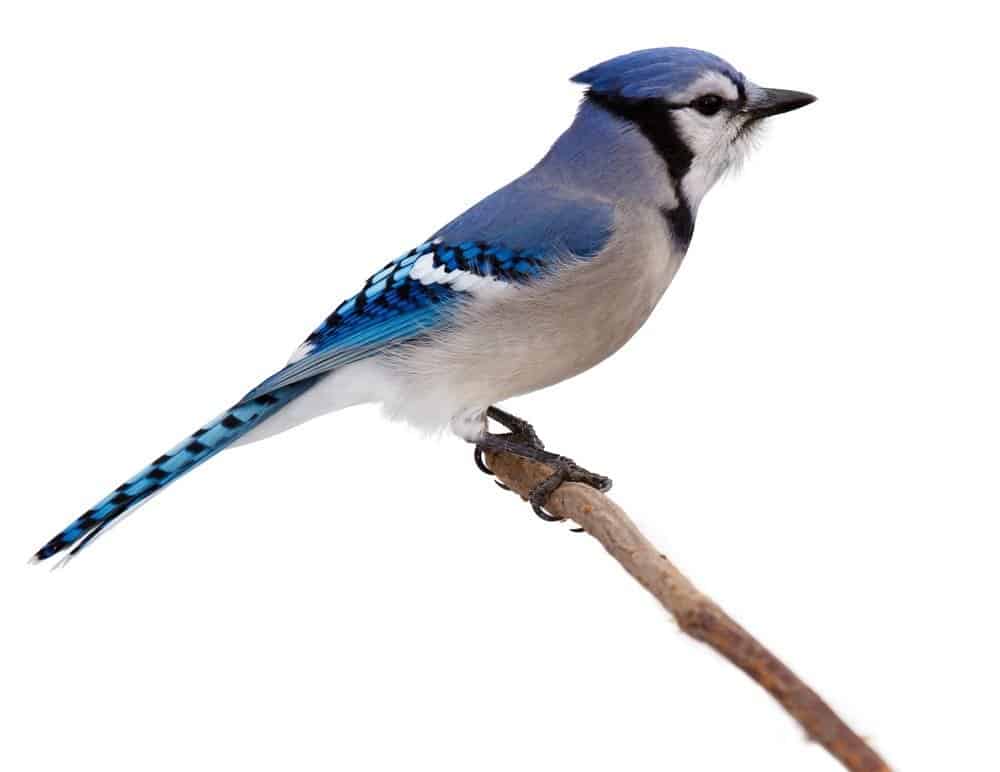
Blue jays live year-round in Maryland, where they live in deciduous and mixed woodlands, towns, and suburban lawns.
©Mike Truchon/Shutterstock.com
Range and Habitat: The blue jay lives year-round in the Eastern United States, including Maryland. You can find them in deciduous and mixed woodlands during the breeding season. But they also inhabit gardens, groves, towns, and suburban lawns.
Coloring: Their palette is blue, black, and white.
Food and Foraging Behavior: These omnivores eat plant matter, insects, spiders, snails, and much more. They forage for food on the ground, shrubs, trees, and feeders.
Fun Fact: They can mimic the calls of red-shouldered hawks.
4. Indigo Bunting
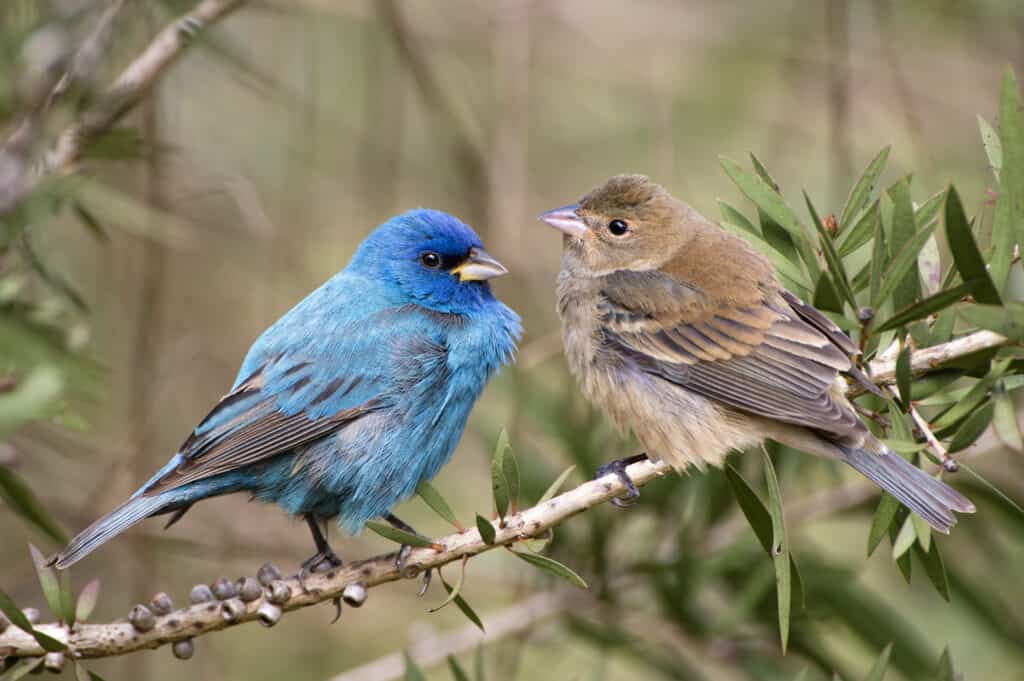
Indigo buntings breed in Maryland and place their nests along roadsides and woodland edges.
©Bonnie Taylor Barry/Shutterstock.com
Range and Habitat: Indigo buntings breed in the eastern half of the United States. You can find them throughout Maryland during the spring and summer. They place their nests along roadsides, woodland edges, and old fields that back up to bushes.
Coloring: They come in shades of sky blue, royal blue, silver, black, and white. While the males have blue plumage during summer and the breeding season, they are brown during winter. The females are colored brown year-round.
Food and Foraging Behavior: They forage for seeds and insects in all levels of shrubs and trees. You will find them alone during the summer.
Fun Fact: They migrate at night and use the stars for guidance.
5. Eastern Bluebird
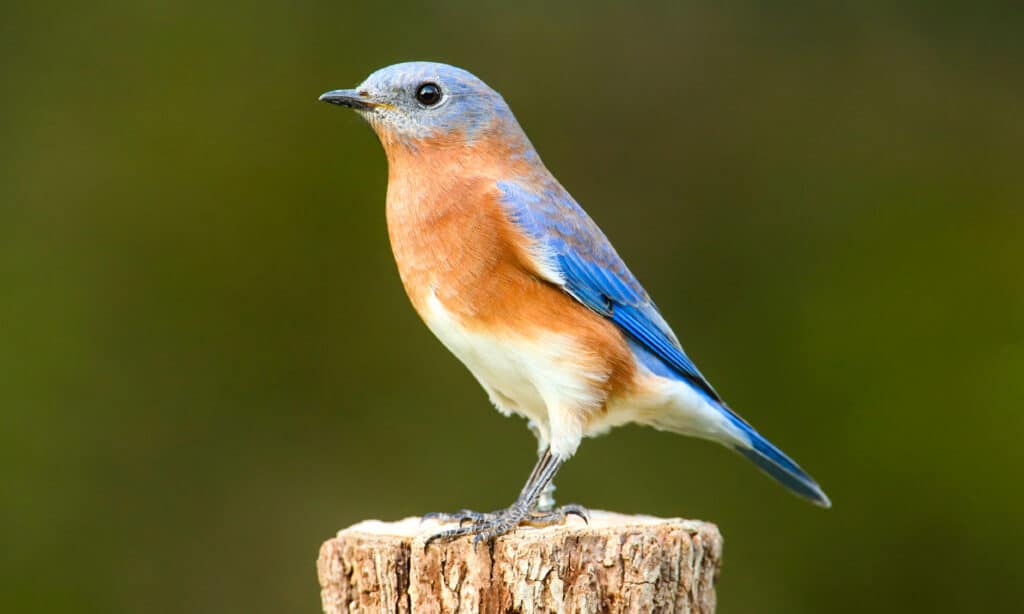
Eastern bluebirds live all year in Maryland, except for the far east. You can find them around farms, roads, and forest clearings.
©Steve Byland/Shutterstock.com
Range and Habitat: The eastern bluebird lives year-round in Maryland, except for small breeding populations in the far eastern counties. They are most common around farms, roadsides, forest clearings, and pine woods.
Coloring: Blue, chestnut, white, and black are their colors.
Food and Foraging Behavior: They eat insects and berries and forage by perching on low branches and fluttering to the ground.
Fun Fact: Bluebirds that live further north lay more eggs than those in the south.
6. Barn Swallow
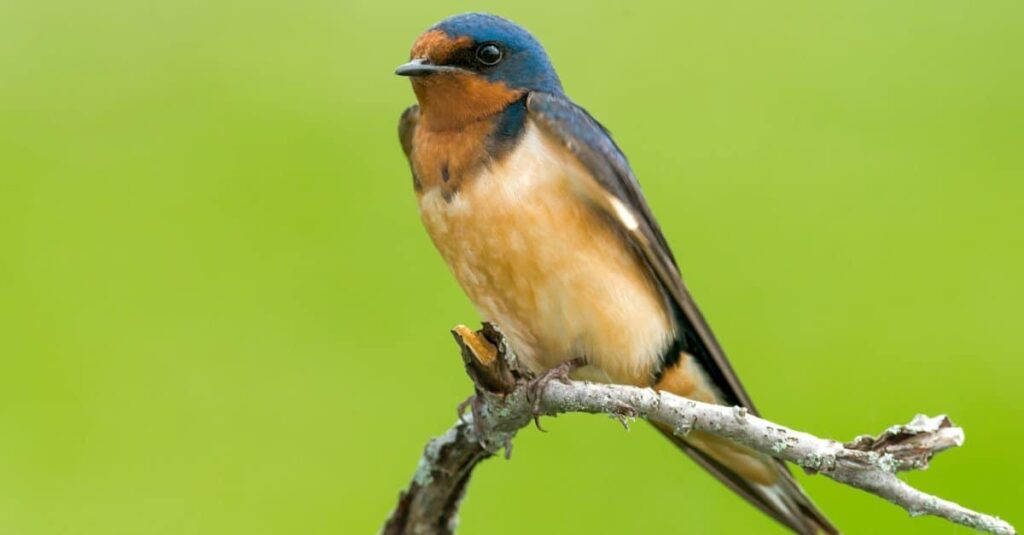
Barn swallows are abundant across the country and breed in Maryland around buildings and farms.
©Paul Reeves Photography/Shutterstock.com
Range and Habitat: The barn swallow is common and abundant across the United States during the spring and summer. They breed in Maryland around buildings, towns, and farms. They forage in fields and ponds.
Coloring: They are a mix of dark blue, tawny, cinnamon, brown, and white.
Food and Foraging Behavior: They feed on a variety of insects, capturing their prey mid-air by flying low over fields and water.
Fun Fact: This swallow species is the most abundant and wide-ranging in the world.
7. Cliff Swallow

Cliff swallows build their nests out of mud on the side of cliffs or buildings.
©iStock.com/Kuhu
Range and Habitat: Cliff swallows primarily live in the Western United States, but some populations find their way to Maryland during the breeding season, especially in areas further west. You can find them near farms, cliffs, and river bluffs.
Coloring: They are dark blue, red, pumpkin, dark brown, and white.
Food and Foraging Behavior: They feed primarily on flying insects and capture them mid-air. You will often find them foraging in flocks.
Fun Fact: They follow other cliff swallows to find food and will give alert calls to summon others.
8. Blue Grosbeak
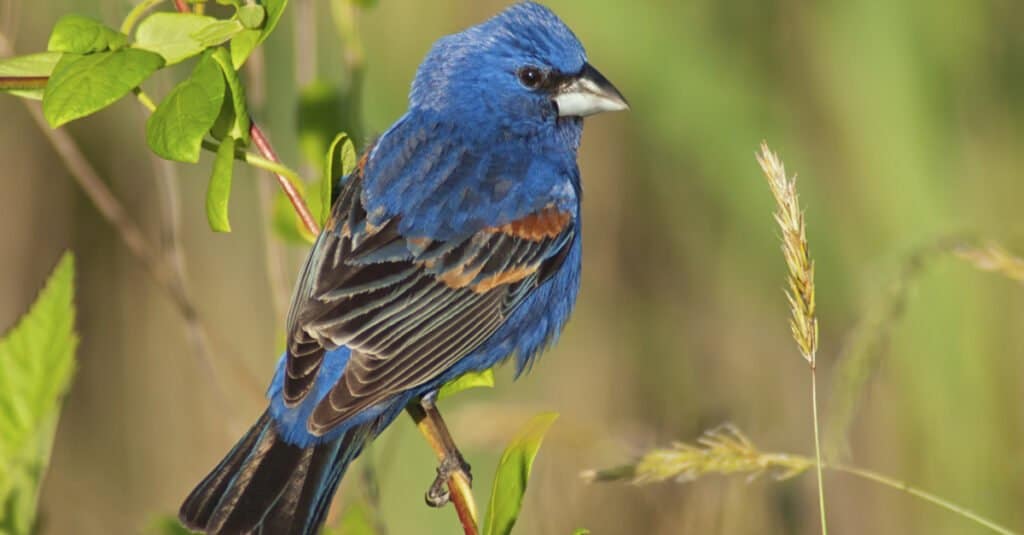
The blue grosbeak breeds along the Maryland coast near woodland edges and brushy fields.
©Michael G. Mill/Shutterstock.com
Range and Habitat: The blue grosbeak primarily breeds in the Southern U.S., but you can still find it in Maryland, especially in areas closer to the coast. Look for them in woodland edges, second growth, and brushy fields.
Coloring: Vibrant blue, chestnut, silver, and black give these birds a unique look.
Food and Foraging Behavior: They eat insects and seeds and spend much of their time looking for food on the ground or in low vegetation.
Fun Fact: They have expanded their range northward, taking advantage of forest clearings.
9. Tree Swallow

Tree swallows spend their summers near ponds, marshes, and lakes in Maryland.
©Feng Yu/Shutterstock.com
Range and Habitat: Tree swallows breed in the Northern United States, migrate through the South, and winter in Mexico and Central America. In Maryland, they spend their summers in many open and semi-open habitats, including ponds, marshes, and lakes.
Coloring: Their colors include bluish-green, white, and dark brown.
Food and Foraging Behavior: They perch in bushes to forage for berries and fly low over the terrain to catch flying insects.
Fun Fact: They form huge flocks with hundreds of thousands of individuals swirling around in the sky before settling into their roosting site.
10. Cerulean Warbler
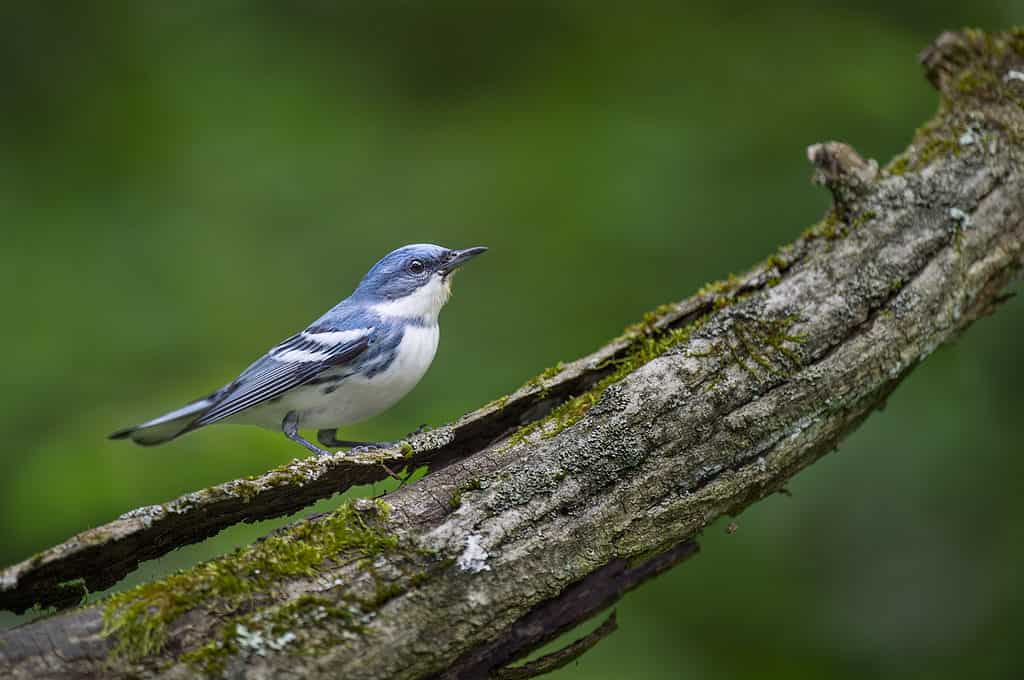
The cerulean warbler is an occasional breeder in Maryland. Look for them in mature hardwoods near streams.
©iStock.com/ps50ace
Range and Habitat: They are occasional breeders throughout most of Maryland, except for the far east, where they typically move through during migration. Cerulean warblers build their nests in mature hardwoods near streams.
Coloring: They are colored sky blue, white, and black.
Food and Foraging Behavior: They are busy foragers, moving speedily from limb to limb high in the trees as they search for insects.
Fun Fact: Females use spiderwebs to hold their nests together, and will even reuse them for a second nest.
11. White-Breasted Nuthatch
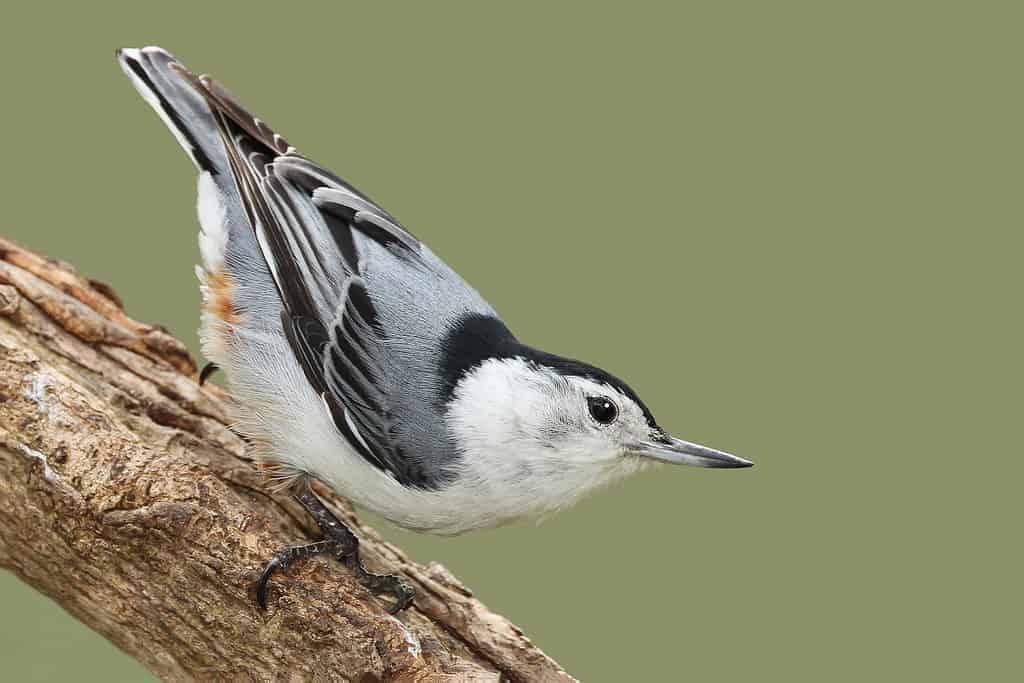
The white-breasted nuthatch can climb up and down tree trunks and large limbs, searching for food.
©Brian Lasenby/Shutterstock.com
Range and Habitat: The white-breasted nuthatch lives year-round in Maryland and most of the United States. This species is common in many areas, including those near human habitations. You can find them in suburbs, parks, groves, forests, woodland edges, and clearings.
Coloring: They are bluish-gray, black, white, and chestnut.
Food and Foraging Behavior: These birds climb up and down tree trunks and large limbs in search of insects and seeds.
Fun Fact: The nuthatch will take many trips to and from bird feeders to store food away for winter.
12. Red-Breasted Nuthatch

People often mistake nuthatches for woodpeckers due to their long, pointed beaks and foraging behavior.
©iStock.com/M. Leonard Photography
Range and Habitat: Most red-breasted populations live year-round in Maryland, except for some populations in the far eastern and western areas that only stay for winter. They live primarily in coniferous forests, but you can find them in any wooded habitat during the colder months.
Coloring: They are bluish-gray, white, black, and rusty brown.
Food and Foraging Behavior: This nuthatch climbs up and down trees looking for insects and seeds, but they also catch insects mid-air.
Fun Fact: They collect tree resin and place it around their nests to help keep predators away.
Summary of 12 Blue Birds in Maryland
Here’s a recap of the dozen birds with blue coloring we took a look at that can be found in Maryland.
| Number | Bird Species | Range | Coloring |
|---|---|---|---|
| 1 | Black-Throated Blue Warbler | Breeds in the far western part of Maryland; migrates throughout the state | Midnight blue, black, and white |
| 2 | Blue-Gray Gnatcatcher | Breeds in Maryland and throughout most of the southeast | Bluish-gray, light gray, white, and black |
| 3 | Blue Jay | Eastern United States, including Maryland | Blue, black, and white |
| 4 | Indigo Bunting | Breeds in the eastern half of the U.S.; throughout Maryland in spring and summer | Sky blue, royal blue, silver, black, and white |
| 5 | Eastern Bluebird | Lives year-round in Maryland, except for small breeding populations in the far eastern counties | Blue, chestnut, white, and black |
| 6 | Barn Swallow | Common and abundant across the U.S. | Mix of dark blue, tawny, cinnamon, brown, and white |
| 7 | Cliff Swallow | Mainly lives in the Western U.S.; some are in Maryland during breeding season | Dark blue, red, pumpkin, dark brown, and white |
| 8 | Blue Grosbeak | Primarily breeds in the Southern U.S.; can be found in Maryland, especially in areas closer to the coast | Vibrant blue, chestnut, silver, and black |
| 9 | Tree Swallow | Breeds in the Northern U.S., migrate through the South, winter in Mexico and Central America | Bluish-green, white, and dark brown |
| 10 | Cerulean Warbler | Occasional breeders throughout most of Maryland | Sky blue, white, and black |
| 11 | White-Breasted Nuthatch | Lives year-round in Maryland and most of the U.S. | Bluish-gray, black, white, and chestnut |
| 12 | Red-Breasted Nuthatch | Mostly lives year-round in Maryland | Bluish-gray, white, black, and rusty brown |
The photo featured at the top of this post is © CezaryKorkosz/Shutterstock.com
Sources
- Maryland.gov, Available here: https://msa.maryland.gov/msa/mdmanual/01glance/html/forests.html
Thank you for reading! Have some feedback for us? Contact the AZ Animals editorial team.






